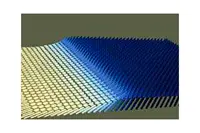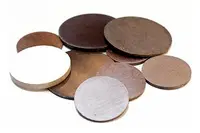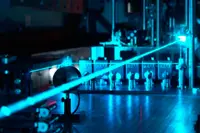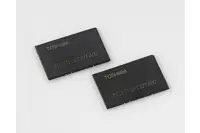Electronics News
Archive : 4 August 2015 год
 A team from the University of California, Berkeley, says it has discovered a new way to switch the polarisation of nanomagnets. The move is said to pave the way for high density storage to move from hard disks onto integrated circuits.
A team from the University of California, Berkeley, says it has discovered a new way to switch the polarisation of nanomagnets. The move is said to pave the way for high density storage to move from hard disks onto integrated circuits.
The team, led by Sayeef Salahuddin, has found that a slight tilt of the magnets makes them easy to switch without an external magnetic field. "To reduce the power draw and increase the speed, we want to be able to manufacture a computer chip that includes memory so that it is close to the computational action," said Salahuddin. "However, the physics needed to create long term storage are not compatible with integrated circuits."
Creating and switching polarity in magnets without an external magnetic field has been a key focus in the field of spintronics. Generating a magnetic field takes power and space, a reason put forward by the researchers why magnets have yet to be integrated onto chips.
In previous research, Salahuddin and his colleagues found that directing electrical current through tantalum creates polarity in magnets without an external magnetic field. Packing a sufficient number of nanomagnets onto a chip meant aligning them perpendicularly, but that vertical orientation negated the switching effects of tantalum.
"We found that, by tilting the magnet – just 2° was enough – you get the benefits of a high density magnetic switch without the need for an external magnetic field," said Salahuddin.
Author
Graham Pitcher
Source: www.newelectronics.co.uk
 Ionix Advanced Technologies has closed a £2million funding round, with backing from IP Group, ParkWalk and private sources. The cash will help the company to accelerate the commercialisation of a range of devices based on its high temperature piezoelectric materials.
Ionix Advanced Technologies has closed a £2million funding round, with backing from IP Group, ParkWalk and private sources. The cash will help the company to accelerate the commercialisation of a range of devices based on its high temperature piezoelectric materials.
A spin-out from the University of Leeds, Ionix is targeting applications where temperatures can reach 420°C, something not possible with conventional piezoelectric devices. Markets for these devices include: energy and nuclear power, refining, aerospace and oil and gas.
Chief executive Dr David Astles said: "Our technology looks ideally placed to play a part in the drive to increase continuous condition monitoring, and we are gaining good traction. I look forward to working closely with the Ionix team and our partners and clients as we move into the next stage of commercial development."
Other applications for the materials include active vibration dampening, electronic frequency filters, transformers and acoustic/vibration sensors.
Author
Graham Pitcher
Source: www.newelectronics.co.uk
 Graphene Flagship researchers have developed an optical fibre laser that can emits pulses just a few wavelengths of light in duration. The device, based on graphene, is thought to be suited to ultrafast spectroscopy and in surgical lasers.
Graphene Flagship researchers have developed an optical fibre laser that can emits pulses just a few wavelengths of light in duration. The device, based on graphene, is thought to be suited to ultrafast spectroscopy and in surgical lasers.
"When engineering light to travel in ultrashort pulses, it is important to understand its wave nature," said Daniel Popa, head of the photonics group at the Cambridge Graphene Centre. "For light to propagate as does a mechanical wave on a stretched cord, the shortest possible pulse is defined by a single wave oscillation."
In the visible and near infrared regimes, where most ultrafast lasers operate, the ultimate pulse duration lies between 2 and 5fs. Shorter pulses require shorter wavelengths.
Pulses as short as two cycles can be generated from laser cavities using a technique known as passive mode-locking. With titanium-sapphire lasers, pulses of 5fs can be produced at a wavelength of 800nm, corresponding to less than two cycles. However, these pulses are not tuneable.
Fibre lasers are said to be attractive for ultrashort pulse generation, because of their relatively simple design, efficient heat dissipation and alignment free operation. Fibre based oscillators allow ultrashort pulses to be generated by passive mode locking, which requires a nonlinear component known as a saturable absorber – and graphene has the ideal physical properties for this application.
The researchers' setup was based on standard telecommunications equipment, with a saturable absorber based on a composite of graphene and polyvinyl alcohol (PVA) fabricated by low-cost solution processing, with the graphene flakes exfoliated from bulk graphite by ultrasonic agitation of the solution. Evaporation leaves behind a 50µm thick graphene-PVA composite, which is then sandwiched between fibre connectors.
With this setup, the researchers generated 29 femtosecond pulses, corresponding to fewer than six cycles at a wavelength of 1.5µm.
Compensating for higher order nonlinear and dispersive effects should lead to a shorter pulse length, while the use of a higher power diode or a double-pumped configuration, could result in higher bandwidth pulses as well as increased output power. Finally, the addition of photonic crystal fibres could in principle allow for the generation of similarly short laser pulses at other wavelengths.
"What is truly remarkable about this project is the ease of combining graphene with off the shelf optical fibres in a highly compact format," Popa concluded.
Author
Graham Pitcher
Source: www.newelectronics.co.uk
 Toshiba has unveiled the latest generation of BiCS FLASH, its 3D stacked cell structure flash memory. The 256Gbit 48 layer device features triple level cell technology and will sample in September.
Toshiba has unveiled the latest generation of BiCS FLASH, its 3D stacked cell structure flash memory. The 256Gbit 48 layer device features triple level cell technology and will sample in September.
Scott Nelson, senior vice president of Toshiba America Electronic Components' memory business unit said: "[This announcement is] significant in that we are enabling a competitive, smooth migration to 3D flash memory – to support the storage market's demand for ever-increasing densities."
The 48 layer stacking process is said to surpass the capacity of 2D NAND flash, while enhancing write/erase reliability endurance and boosting write speeds. The 256Gbit device is expected to find application in products ranging from consumer and enterprise solid state drives (SSDs) to smartphones and memory cards.
Since announcing BiCS FLASH technology in June 2007, Toshiba has continued to optimise the technology. Looking to meet growth in demand for flash memory, the company is developing a product portfolio that focuses on large capacity applications, such as SSDs.
Nelson added: "From day one, Toshiba's strategy has been to extend its floating gate technology, which features the world's smallest 15nm 128Gbit die."
Author
Graham Pitcher
Source: www.newelectronics.co.uk

